- Clinical Technology
- Adult Immunization
- Hepatology
- Pediatric Immunization
- Screening
- Psychiatry
- Allergy
- Women's Health
- Cardiology
- Pediatrics
- Dermatology
- Endocrinology
- Pain Management
- Gastroenterology
- Infectious Disease
- Obesity Medicine
- Rheumatology
- Nephrology
- Neurology
- Pulmonology
Economic Burden Associated With Parkinson Disease
The objective of this study was to estimate the annual cost burden of Parkinson disease (PD) in the United States. Resource use and cost profiles were developed using all-payer statewide hospital discharge data from 6 states; emergency department visit, long-term–care, and national survey data; fee schedules; and published study findings. (Average direct and indirect costs per patient were calculated in 2007 US dollars.) The annual cost per patient was $21,626 (direct cost: $12,491). When applied to the US PD population (N = 500,000), the annual average cost was approximately $10.78 billion (direct costs, $6.22 billion; indirect costs, $4.56 billion). PD has substantial economic consequences for patients and their families, insurers, and society. (Drug Benefit Trends. 2009;21:179-190)
Parkinson disease (PD) is the second most common neuro- degenerative disease in older adults after Alzheimer disease. The prevalence of PD cases in the United States has been reported to be between 349,000 and 1.5 million.1,2 By 2030, prevalence is expected to at least double.3 Available pharmacological treatments, such as levodopa and dopamine antagonists, only ame- liorate the symptoms of PD. These medications improve the quality of life for persons with PD but do not stop progression of the disease.
PD has a substantial impact on patients, those caring for patients, and the health care system. Families currently provide the majority of informal care for this population. As the disease progresses, patients are less able to provide self-care, or even to be left alone safely, thereby increasing the burden4,5 on informal (unpaid) caregivers and health care resources in the United States.6,7
There are significant economic consequences related to this burden. A 2004 report of the National Institute of Neurological Disorders and Stroke estimated the annual cost to the United States to be $6 billion.8
In the past, a comprehensive examination of a clinical condition would focus almost exclusively on areas considered relevant to patient management, such as diagnosis, etiology, treatment, and prognosis. Now, however, additional demands are being made by health policy decision makers, who can influence medical decisions through coverage and reimbursement policies. Physicians and other professional caregivers increasingly must consider the economic implications of their decisions, which has led to increased demand for disease-specific cost information.
Until recently, “cost” studies of a given illness were typically compilations of all the financial consequences, reported in broad catego- ries, such as the previously referenced $6 billion annual cost estimate for PD. Although an impressive amount, this type of estimate alone is not informative to guide health care decisions. Cost estimates reported in sufficient detail at the level of the relevant components of the illness (eg, inpatient management, nursing home care) are more meaningful to clinicians and form the basis for inputs to an economic model that evaluates the cost-effectiveness of various therapies for PD. Thus, the objective of this study was to examine and report current and comprehensive costs associated with PD in the United States at a detailed level to help policymakers determine how to properly allocate funds and other resources that will be required to address the increasing health care demands of the PD population.
Methods
Ideally, a comprehensive resource use and cost data profile for all PD-related care would be available for every patient by level of disease severity. Unfortunately, such data profiles do not exist. In the United States, there is no one database whereby all resource use and costs for a given illness can be accessed at a patient level. Even large databases compiled by Medicare, HMOs, and other insurers do not contain complete information on all resource use because some levels of care (eg, custodial) and care locations (eg, nursing homes) are not covered services; therefore, relevant data for those services are not captured. Furthermore, databases that contain resource use and cost data typically do not capture disease severity. Thus, it is not possible to estimate the cost of PD using only direct data analysis.
To circumvent this obstacle, our approach to determining the annual cost of a chronic clinical problem, such as PD, was to conceptualize the clinical management and related nonclinical consequences in cost-relevant terms for the full population affected by the condition. Although any given person with PD may be at a certain clinical level in the course of the illness, it is not the severity of the illness, but rather the level of health care resources used that is cost-relevant. For example, if a patient’s condition is severe enough to warrant admission to a nursing home, but the patient is not admitted and returns home instead, that resource is not used. In this case, the patient’s clinical severity changed, but no nursing home cost was incurred. This approach has been used for estimating the costs of other chronic conditions.9 For this analysis, health care resource use refers to any goods or services used in the care of persons with PD.
To determine the annual cost burden of PD, it is necessary to take a snapshot of the PD population for a period of 1 year and identify where in the spectrum of management levels a person with PD may be. For a population with PD, any year will be like any other regarding resource use because the population is in a steady state: some persons have newly diagnosed PD, others will become more chronically ill, and some will die. Thus, the population is renewed by persons passing through these states each year. While the disease course for individuals may vary, cost-relevant resource use levels can be identified for the population as a whole.
A prevalence-based approach using a combination of direct data analysis and cost modeling was employed to estimate the costs accrued during 1 year by persons with an existing diagnosis of PD. (Costs associated with establishing a diagnosis of PD are not included.) Cost modeling is a multistep process involving the identification (development of typical resource use profile), quantification (determination of frequency of use and proportion of users for each resource), and valuation (unit cost applied to each resource) of relevant health care goods and services.9-11
Resource level assignment. Each person with PD was categorized for the year into 1 of 4 PD-relevant resource levels: chronic, noninstitutionalized management with a nonfatal acute event; chronic, noninstitutionalized management without an acute event; permanent nursing home (institutionalized) care; and death.
To determine the proportion of persons with PD appropriate to each resource use level, data from the National Health Interview Survey on Disability (NHIS-D),12 the National Ambulatory Medical Care Survey (NAMCS),13 and the literature were abstracted and analyzed. Data provided in a population-based study of PD by Parashos et al14 were used to calculate the proportion of resource use for institutionalized and for noninstitutionalized patients. One-year mortality rate for institutionalized patients was obtained by analyzing statewide nursing home data from Minnesota.15 The NHIS-D data on persons with PD who were hospitalized in a 1-year period and those who participated in the NAMCS and received outpatient care for PD for an acute problem were used to calculate rate of acute events in noninstitutionalized patients.12,13 The International Classification of Diseases, Ninth Revision, Clinical Modification (ICD-9) code 332.0 for “Paralysis agitans”16 was used to identify cases in these and other databases used in the analyses.
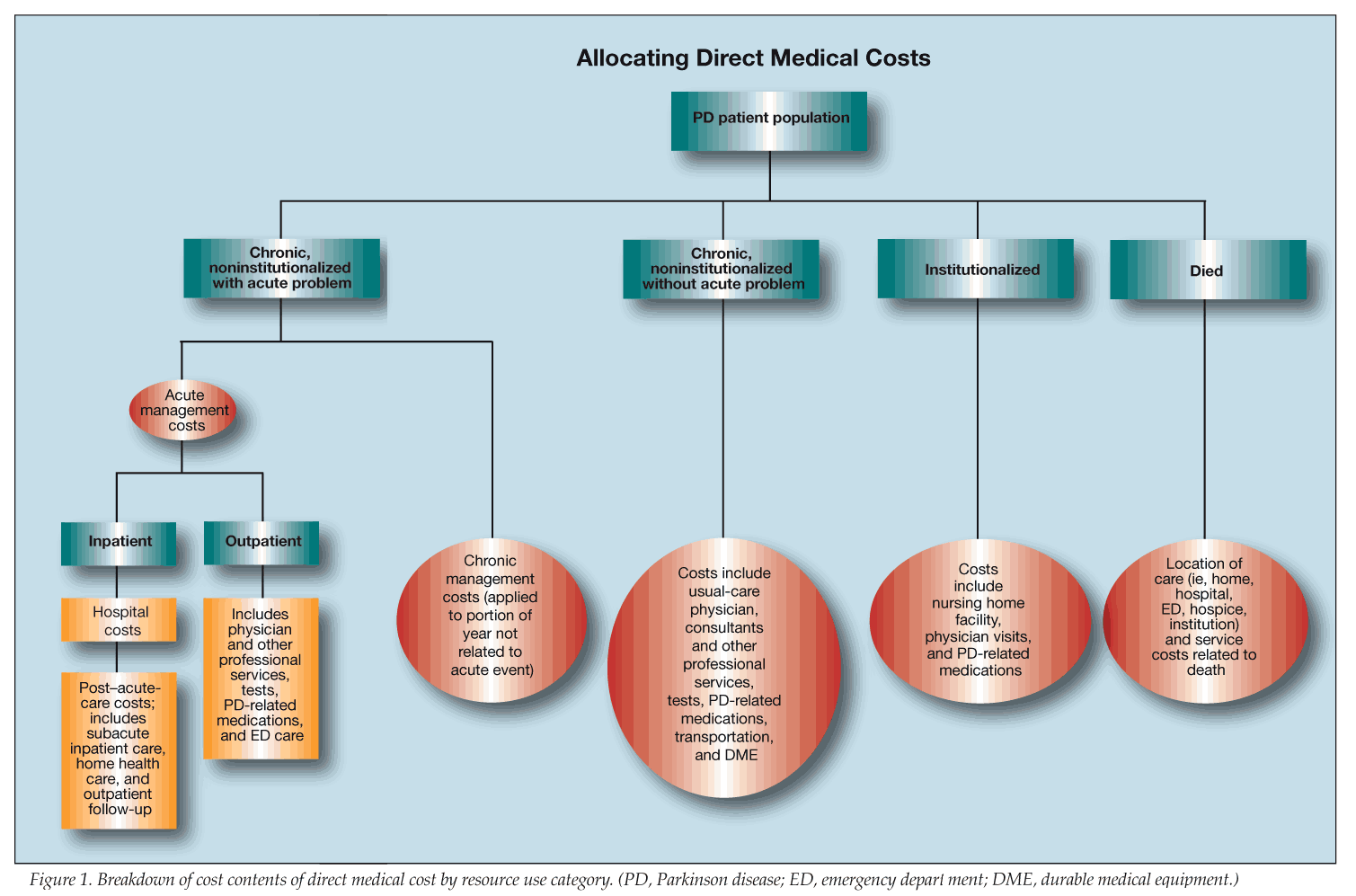
Cost development. A separate cost profile was established for each resource use level (Figure 1). The average annual cost per patient per level was calculated and applied to the proportion of patients with PD at that level (Figure 2). In this analysis, the cost of some resource use levels (ie, acute event, death) was calculated to consider the chronic management costs associated with the portion of the year not covered by those events.
Direct medical costs (accrued from the use and delivery of health care services, such as physician visits, medications, and diagnostic tests) and indirect costs (resulting from the clinical problem but not directly related to the clinical management of the condition itself, such as loss of income or productivity) were examined. It is not possible to identify all indirect costs on the basis of available data; therefore, for this analysis, indirect costs were limited to lost wages for persons with PD who were employed12 but missed work because of PD and for informal caregivers who stopped work to care for them,4 as well as to out-of-pocket (OOP) expenses for in-home personal care17,18 and death-related costs at each resource use level.
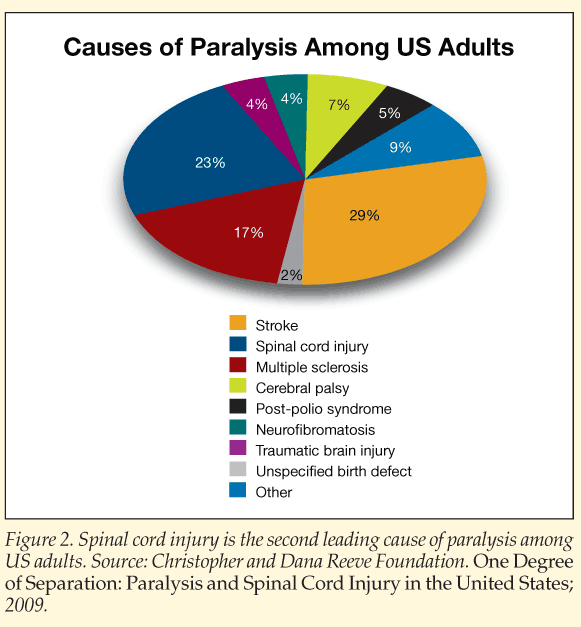
Acute-event resource use level. Persons with PD who had a nonfatal inpatient stay or were seen as an outpatient for an acute PD or PD-related problem were assigned to the acute-event management level. Separate inpatient and outpatient event cost profiles were developed and applied to the appropriate proportion of persons with PD who used those services.12 For those who experienced a nonfatal acute event, the average annual direct cost included all acute and related post–acute-care (PAC) costs, along with chronic, noninstitutionalized management costs for the portion of the year not represented in the acute episode. The chronic management portion will differ for each person depending on the type and length of PAC received. For example, a patient who was admitted to the hospital, discharged to a subacute-care facility, and ultimately discharged to home will have an acute-event period lasting the number of days in the hospital plus the number of days in the subacute facility. If the average hospital length of stay (LOS) was 6 days and the average subacute-facility stay was 25 days, the total acute episode would be 31 days (8% of the year). For that patient, the mean cost of the hospital and subacute stay, as well as postdischarge acute outpatient care, would be counted, along with 92% of the average chronic, noninstitutionalized annual management cost. Care was taken to avoid double-counting of resources allocated to the acute- and chronic-care profiles.
Inpatient costs, which include preadmission emergency department (ED) care, all accommodations (eg, routine care, intensive care), and ancillary services (eg, pharmacy, laboratory) were derived for persons discharged following the stay from an analysis of all-payer discharge data from about 1000 hospitals in 6 states.19-24 All patients with a principal diagnosis of PD were included in the hospital analysis. Patients with a secondary diagnosis of PD were included only when the principal diagnosis was a PD-related symptom (eg, incontinence) or condition (eg, atony of bladder, depression). Physician fees are not included in the hospital discharge databases; therefore, the average Medicare payment for inpatient physician services was adjusted to reflect all payers on the basis of distribution of patients’ ages (older or younger than 65 years).25,26
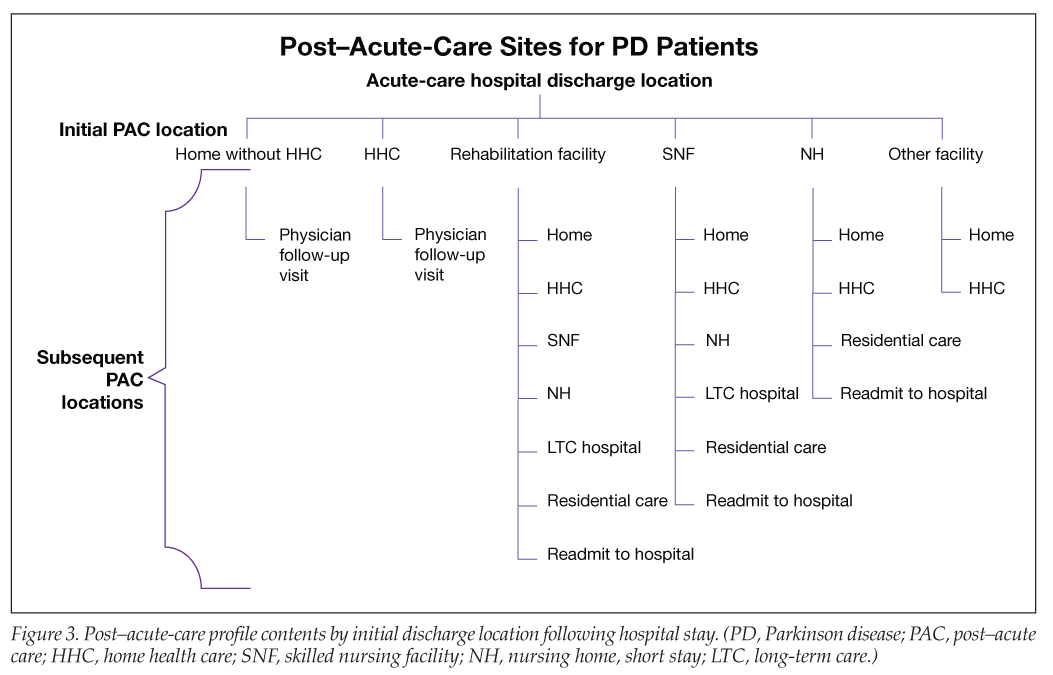
The overall PAC cost per patient was arrived at by determining the average cost incurred by a patient in each discharge location category based on typical resource use. This cost was multiplied by the proportion of surviving patients who were discharged to that location (eg, mean cost per skilled nursing facility [SNF] stay is multiplied by the percentage of patients discharged to an SNF). Discharge location data from each PAC location,15,27 when available, were used to determine subsequent pattern and length of PAC for the year (Figure 3).
Readmission rate to an acute-care hospital for a PD-related problem within the year was determined by analyzing patient-level discharge data in Massachusetts.22 Resource use and cost information for PAC profiles were obtained by means of direct data analysis12,15,19-24 and abstraction of published data.27-31 For those admitted to an acute-care hospital from a subacute-care facility or nursing home, the average costs for a hospital stay (all cause) and physician services reported by the Centers for Medicare & Medicaid Services (CMS)29 were applied, since the reason for hospital admission was not known. For hospitalized patients discharged directly home for outpatient follow-up, the PAC cost was limited to 1 follow-up physician visit to avoid double-counting, because chronic outpatient management costs were applied to the portion of the year not covered by the hospital stay.
The acute-event outpatient profile takes into consideration those who seek acute treatment from their usual-care physician in an office setting and those who go to the ED. For those given acute care in the ED, who were subsequently treated and released and not admitted to inpatient care, the average cost of the ED visit, including tests and services performed during the visit, was derived from our analysis of 144 ED patients32 whose primary reason for the visit was PD. The physician’s fee for the ED evaluation was added. For those treated by their usual-care physician, the cost profile was developed in a manner similar to that for chronic noninstitutional management without an acute event (described below).
Chronic, noninstitutional management without an acute-event resource use level. Outpatient care cost profiles were developed primarily from resource use data from the 2007 NAMCS.13 For patients who present with PD as the primary reason for the visit, the general reason for the physician encounter variable was used to discern a routine visit for a chronic condition from a visit to the physician for an acute problem. Chronic and acute problem management profiles were developed. These data were supplemented with additional resource use information from the NHIS-D survey12 and published CMS information.29 The daily cost of PD-related medications was included in the outpatient cost estimates. Recommended doses for medications were identified,33 and average wholesale prices (AWPs) were obtained.34 For persons 65 years and older, the Medicare national physician and laboratory fee schedules35,36 were applied to estimate the cost of relevant outpatient services. For younger persons, Medicare fees were adjusted with ratios derived from published fees for common types of insurers (ie, Medicaid, preferred provider organizations, and indemnity plans).25,26
Institutionalized resource use level. The institutionalized level pertains only to those persons living in a nursing home for the full year. The average cost per day of nursing home care for a person with PD was calculated using the Minnesota long-term–care (LTC) database.15 The cost of physician visits was based on information in the literature,31 with unit costs taken from the aforementioned fee schedules. In addition, the cost of PD-related medications was added because it is not included in the facility cost. Because no information regarding the PD-related drug profile was available in the Minnesota database, the average medication cost for those in the chronic, noninstitutionalized management level was used. For those transferred to an acute-care hospital during the year, the acute-care hospital cost described previously when the cause of admission was not known was also added.15
Resource use level for patients who died. For persons with PD who died during the year, direct medical costs were calculated on the basis of location of death (ie, hospital, hospice, ED, home, nursing home) using database analyses12,15,19-24,32 and data abstraction14 applied to the proportion of persons with PD who died at that location. Relevant LTC costs were applied for the portion of the year the persons were alive.
Indirect costs. Average wages and hours worked were obtained from the US Bureau of Labor Statistics37 and applied to the average number of workdays missed38 because of PD for patients and caregivers.4,12 The annual OOP expense for a personal care aide was calculated for those persons who received this service.17,18 Death-related indirect costs were derived from published information and included a monthly Social Security death benefit paid to a patient’s family, a one-time death benefit payment, funeral expenses, and related OOP expenses.39-41
Annual cost of PD. The average annual direct medical cost per PD patient was estimated by multiplying the average cost for each resource use level by the proportion of PD patients in each level. Cost estimates were then extrapolated to the US population assuming 500,000 Americans are affected at any given time, with severity varying from person to person.42
Cost Estimates
These costs are meant to reflect the economic value of the resources consumed regardless of who actually pays for them (eg, Medicare, Medicaid, or a commercial insurer). Thus, they do not take into account adjustments made in the multipayer US system, such as differences in coverage of medications, copayments, reimbursement rates, and volume discounts.
All cost estimates are reported in 2007 US dollars. Where 2007 values were not available, older estimates were inflated using rates based on the medical care component of the US Consumer Price Index.43 Any charges used as inputs (eg, inpatient hospital care) were adjusted to costs using a cost to charge ratio (0.514).44 Where single-state databases were used, state-specific costs were adjusted to national values.29
Results
In 1 year, 23% of noninstitutionalized patients with PD will experience an acute problem, 11% will spend the year in an institution, 12% will die, and 54% will have chronic problems that are managed on an outpatient basis.
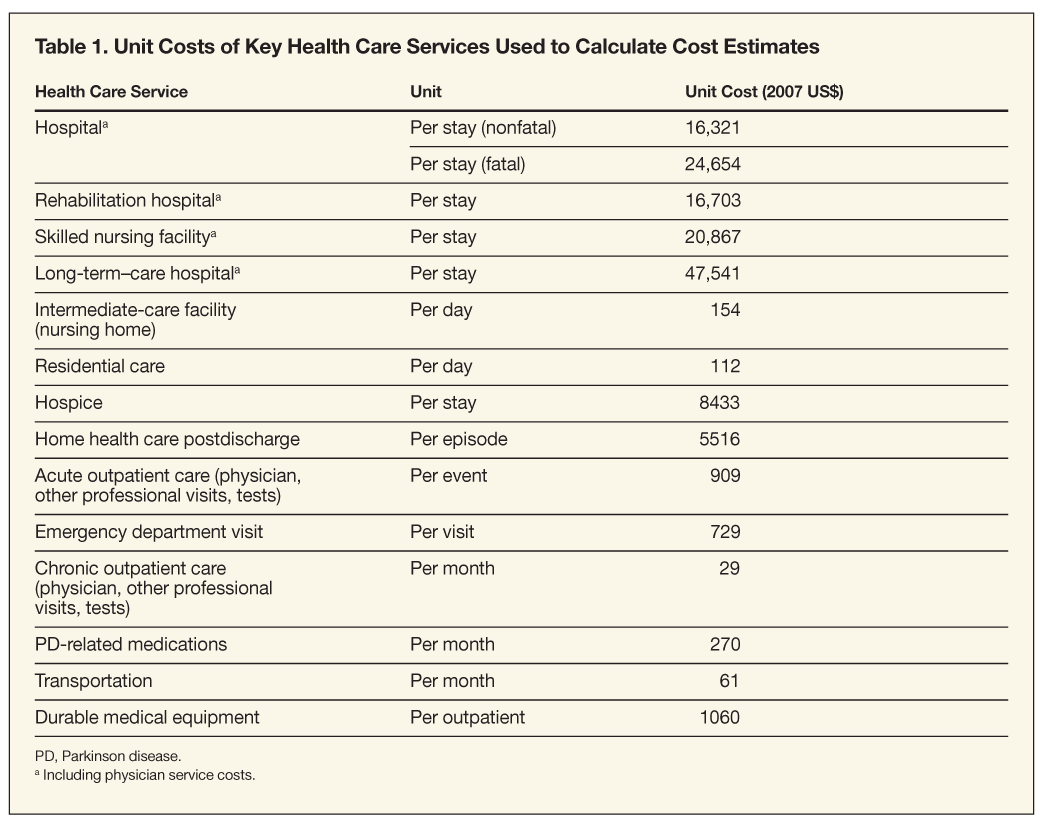
Chronic, noninstitutionalized with acute problem. Persons with an acute PD-related problem may be admitted or managed as outpatients. Details of the cost estimates and resource use profiles are provided in Tables 1 and 2, respectively. The data analysis for a 1-year period included examination of patients from NHIS-D who were hospitalized (n = 204,787), hospital discharges from state databases (n = 18,309; mean age, 77 years; 20% younger than 65 years), and acute (n = 103,787) and chronic care (n = 728,944) outpatient visits from NAMCS. During 1 year, 28% were hospitalized (mean cost, $16,447 per stay; LOS, 5.3 days). Of those discharged (98%), most received PAC services (Table 2) initially. Almost one-third (30%) were readmitted with a PD-related problem at least once (mean, 1.47; range, 1 - 16) during the next 12 months.
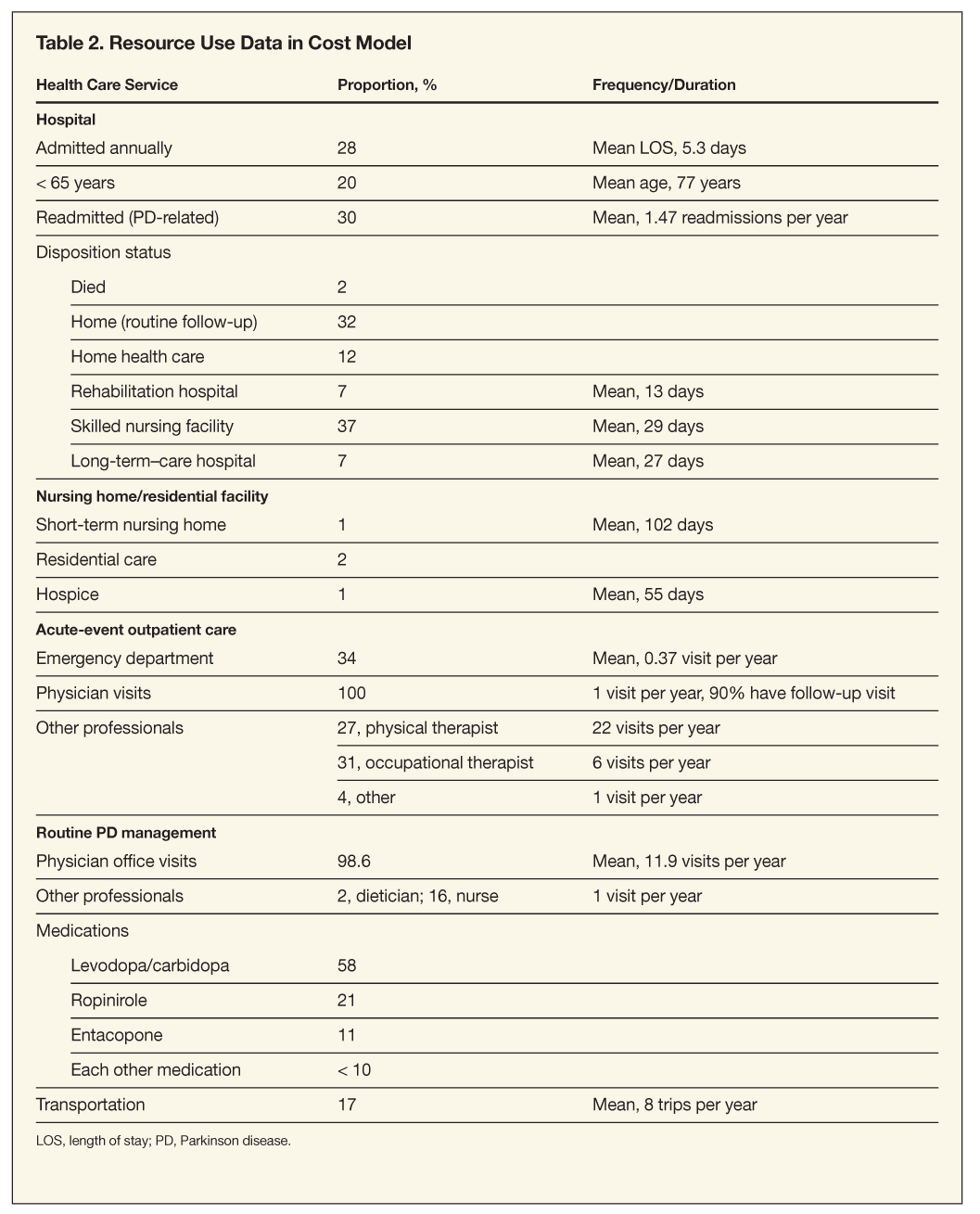
Hospital costs (including readmissions) were estimated at $24,000 per patient per year. When PAC costs are added, the total average annual cost for a person with PD who was hospitalized was estimated to be $39,096. The average acute outpatient event management cost was estimated at $1816, based on the cost of visits to usual and consulting physicians, nurses, and dieticians; tests; ED care; and PD-related medications. Thus, per patient experiencing acute problems, the annual direct medical cost was estimated at $16,610 (after including chronic management costs, as well as acute-care costs).
Chronic, noninstitutionalized. The annual direct medical cost for chronic medical care was estimated at $3573 (physician visits, tests, medications) per noninstitutionalized patient (Table 3). PD-related medications accounted for 90% of this cost. The cost increases to $5363 per person when transportation and durable medical equipment costs are included.
Institutional care. When facility, physician, medication, and acute readmission costs are included, the annual direct medical cost per institutionalized patient who was alive for the full year (78%) was estimated at $47,807.
Persons who died. On average, when chronic management costs are included, those who died at home (98%) accrued $2927 in annual direct medical costs. The cost increased substantially for persons with PD who died in an ED (mean, $7968), during an acute-care hospital stay (mean, $27,453), while receiving hospice care (mean, $10,843), or while institutionalized (mean, $31,312). When these costs were applied proportionately, the estimated direct medical cost per patient who died averaged $3769.

Overall, the annual direct medical cost per PD patient was estimated to be $12,491, with nursing home facility costs accounting for 41% of direct costs, followed by outpatient PD-related medications (22%) (Figure 4).
The indirect costs took into account lost workdays for persons with PD (10.6%) as well as caregivers (24%) and personal care aide use (31%). For persons who died, indirect costs also included Social Security death benefit ($920/mo), death benefit payment ($255), and funeral and related expenses ($7518).
Overall, the annual indirect cost per person with PD was estimated at $9135 (23% attributed to lost wages, 51% for caregiver lost wages, 2% for personal care aide expense, and 24% for death-related costs).
Combining direct medical and indirect costs, the overall average cost per person with PD per year is $21,626.
US PD population costs. When extrapolated to the US PD population, the annual cost of managing PD was $10.78 billion, with direct medical costs accounting for 58% ($6.22 billion) of this total. Nursing home care ($2.6 billion) and PD- related medications ($1.47 billion) accounted for 63% of direct medical costs. Indirect costs totaled $4.56 billion, with annual lost productivity for persons with PD estimated at about $1 billion and $2.36 billion for caregivers.
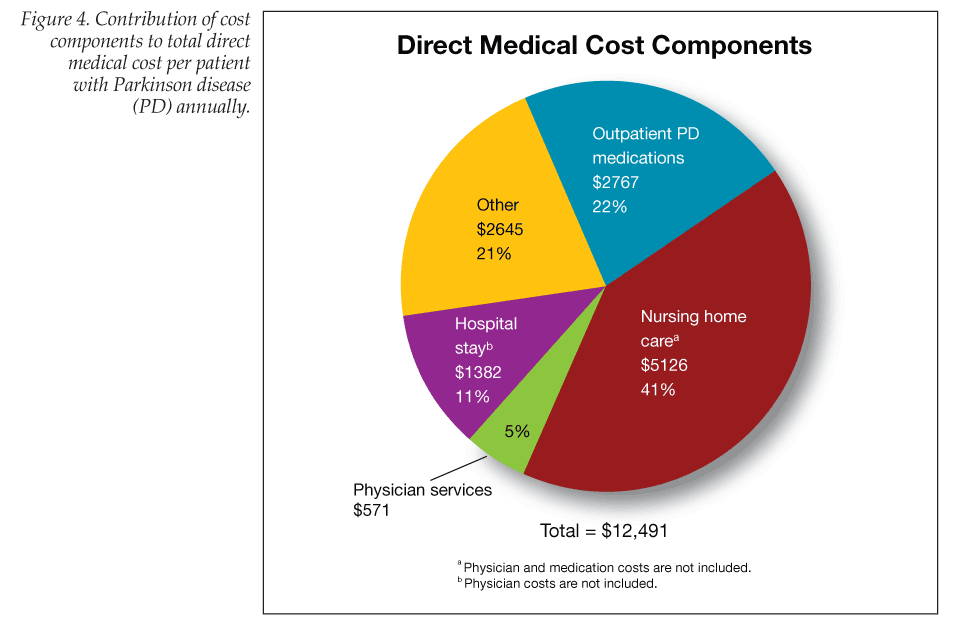
Discussion
The prevalence of PD cases in the United States has been reported to be between 349,000 and 1.5 million.1,2 Assuming a conservative PD population estimate of 500,000, we calculated the annual direct cost of PD to be $6.22 billion. The total cost increases to nearly $11 billion when indirect costs are included. The indirect costs are substantial because of lost productivity; either persons with PD or their caregivers may be forced to leave their jobs pre- maturely, resulting in sizable lost earnings.6,7,18,45,46
Cost estimates in the literature vary greatly, ranging from $4026 per person with PD in a small community-based study to upward of $23,000 in a database study of both community and institutionalized populations.18,45,47-51 Direct per patient costs in the current analysis fell around the middle of this range ($12,491), but because the cost components, populations, and methods vary, comparisons between studies are difficult. In investigating both community and facility populations, Huse et al47 reported a comparably high proportion of costs attributed to nursing home/residential facility care (nearly 50%), with PD-related medications accounting for just 14%.
As noted previously, no single data source was available that could provide all of the information required to derive PD-associated costs, necessitating data acquisition from a variety of sources. Each source has advantages and limitations. For example, cost estimates of hospital and ED care were derived from direct data analysis of large samples of patients in claims datasets. While these databases reflect the care provided in actual practice settings, they do not support differentiation by stage of disease. PD-related medications accounted for almost a quarter of annual costs. However, it should be noted that this estimate was arrived at using AWPs and thus probably overstates the cost that most pay for medications. Although the productivity losses for persons with PD were derived by specific analysis of the national survey data (NHIS-D) and published information on the number of days lost from work,12 estimates for the lost productivity of the caregiver relied on published results from small surveys and studies.
As with all cost of illness (COI) studies, the estimates in this study are affected by uncertainties stemming from their development from many sources and provide incomplete measures of the burden of disease because they do not evaluate the impact of PD on all potential cost components. The psychosocial impact of illness and disability often extends to family, friends, and caregivers; lost leisure time; and OOP costs. These costs are not included in our COI estimates. Thus, our $11 billion estimate is likely conservative. Although it may be possible to reduce uncertainty by collecting detailed and comprehensive data on utilization of health care, undertaking such a large data collection study is cost-prohibitive. The cost modeling approach adopted for this study is an acceptable alternative for providing the most comprehensive costs reported for PD to date.
On the basis of our calculations, PD cost the United States $10.78 billion in 2007. Because the risk of developing PD increases with age, the aging of the population is expected to lead to a substantial increase in the number of persons with PD, which will expand the economic burden. The cost information in this report is provided at a level to facilitate incorporation into other economic models, such as those that examine the cost-effectiveness of existing and new therapies for PD. These costs may contribute to a better understanding of the major determinants of PD costs, which, in turn, will assist practitioners as well as policymakers in determining the resources needed and the optimal allocation of those resources for managing this increasingly prevalent disease.
Acknowledgments
The authors also wish to thank Piedad Alvarez and Clare Pitoniak-Morse of United BioSource Corporation for their contribution to the analysis and preparation of this article.
Funding for this study was provided by Bayer Schering Pharma.
References:
References
1. National Parkinson Foundation. About Par- kinson disease. http://www.parkinson.org/ NETCOMMUNITY/Page.aspx?&pid=225& srcid=201. Accessed April 6, 2009.
2. Hirtz D, Thurman DJ, Gwinn-Hardy K, et al. How common are the “common” neurologic disorders? Neurology. 2007;68:326-337.
3. Dorsey ER, Constantinescu R, Thompson JP, et al. Projected number of people with Parkinson disease in the most populous nations, 2005 through 2030. Neurology. 2007;68:384-386.
4. Parrish M, Giunta N, Adams S. Parkinson’s disease caregiving: implications for care management. Care Manag J. 2003;4:53-60.
5. Roos RA, Jongen JC, van der Velde EA. Clinical course of patients with idiopathic Parkinson’s disease. Mov Disord. 1996;11:236-242.
6. Chrischilles EA, Rubenstein LM, Voelker MD, et al. The health burdens of Parkinson’s disease. Mov Disord. 1998;13:406-413.
7. Noyes K, Dick AW, Holloway RG; Parkinson Study Group. Pramipexole v levodopa as initial treatment for Parkinson’s disease: a randomized clinical-economic trial. Med Decis Making. 2004; 24:472-485.
8. National Institute of Neurological Disorders and Stroke. Parkinson’s Disease: Challenge, Progress, and Promise. Bethesda, MD: National Institutes of Health; November 2004. NIH publication 05-5595. http://www.ninds.nih.gov/disorders/ parkinsons_disease/parkinsons_research.htm. Accessed March 18, 2009.
9. O’Brien JA, Ward AJ, Patrick AR, Caro J. Cost of managing an episode of relapse in multiple sclerosis in the United States. BMC Health Serv Res. 2003;3:17.
10. Caro JJ, O’Brien JA. Costs of venous thrombo- embolism in the United States. In: Dalen JE, ed. Venous Thromboembolism. New York: Marcel Dekker, Inc; 2003.
11. O’Brien JA, Patrick A, Caro JJ. Costs of managing CAP are double for elderly patients. Drug Benefit Trends. 2003;15(6):32-47.
12. National Center for Health Statistics. 1995 National Health Interview Survey on Disability. CD-ROM Series 10, No 10A. SETS Version 2. Washington, DC: US Government Printing Office; 1999.
13. National Center for Health Statistics. National Ambulatory Medical Care Survey (NAMCS). Hyattsville, MD; May 17, 2007.
14. Parashos SA, Maraganore DM, O’Brien PC, Rocca WA. Medical services utilization and prognosis in Parkinson disease: a population-based study. Mayo Clin Proc. 2002;77:918-925.
15. Nursing Facility Rates and Policy Division. Minnesota Department of Human Services. http://www.dhs.state.mn.us/main/idcplg? 1dcService=GET_DYNAMIC_CONVERSION& RevisionSelectionMethod=LatestResearch& dDocName=id_00268. Accessed March 18, 2009.
16. Hart AC, Hopkins CA, eds. 2005 ICD-9-CM Professional for Physicians. West Valley City, UT: Ingenix, Inc; 2004.
17. 2006-2007 Homecare Salary & Benefits Report. Oakland, NJ; Hospital and Healthcare Compensation Service; October 2006.
18. Whetten-Goldstein K, Sloan F, Kulas E, et al. The burden of Parkinson’s disease on society, family, and the individual. J Am Geriatr Soc. 1997;45: 844-849.
19. California 2005 Public Patient Discharge Data on CD-ROM. Sacramento, CA: Office of Statewide Health Planning and Development; 2007.
20. Florida 2005 Hospital Inpatient Data File on CD-ROM. Tallahassee, FL: State of Florida, Agency for Health Care Administration, State Center for Health Statistics; 2007.
21. Maryland 2005 Inpatient Public Use Data File on CD-ROM. Glen Burnie, MD: St Paul Computer Center, Inc; 2007.
22. Massachusetts Fiscal Year 2005 Acute Hospital Case Mix Level III Database on CD-ROM. Boston: Massachusetts Division of Health Care Finance and Policy; 2007.
23. Washington 2005 CHARS (Comprehensive Hospital Abstract Reporting System) Public Data File on CD-ROM. Olympia, WA: Washington State Department of Health, Office of Hospital and Patient Data; 2007.
24. New Jersey 2005 State Inpatient Database (SID). Healthcare Cost and Utilization Project (HCUP). Rockville, MD: Agency for Healthcare Research and Quality; 2007.
25. Verrilli DK, Zuckerman S. Preferred provider organizations and physician fees. Health Care Financ Rev. 1996;17:161-170.
26. Direct Research, LLC for the Medicare Payment Advisory Commission (MedPAC). Medicare Physician Payment Rates Compared to Rates Paid by the Average Private Insurer, 1999-2001. Washington, DC: Medicare Payment Advisory Commission; August 2003. Publication 03-06. http:// www.medpac.gov/publications/contractor_ reports/Aug03_PhysPayRates(cont)Rpt.pdf. Accessed April 20, 2009.
27. Florida Agency for Health Care Administration State Center for Health Statistics. Florida nursing home resident data report. Tallahassee, FL; January 2001.
28. Centers for Medicare and Medicaid Services. Medicare and Medicaid statistical supplement, 2000. Health Care Financing Review. US Dept of Health and Human Services. Baltimore: Health Care Financing Administration Office of Strategic Planning; 2001.
29. Centers for Medicare and Medicaid Services. Medicare and Medicaid statistical supplement, 2004. Health Care Financing Review. Baltimore: Office of Research and Demonstrations; April 2006. Publication 03469.
30. Medicare Payment Advisory Commission. (MedPAC). Report to the Congress: New Approaches in Medicare. Washington, DC; June 2004. http://www.medpac.gov/documents/June04_Entire_Report.pdf. Accessed April 20, 2009.
31. Manton KG, Cornelius ES, Woodbury MA. Nursing home residents: a multivariate analysis of their medical, behavioral, psychosocial, and service use characteristics. J Gerontol A Biol Sci Med Sci. 1995;50:M242-M251.
32. Massachusetts Fiscal Year 2005 Emergency Department Visit Level III Database on CD-ROM. Massachusetts Division of Health Care Finance and Policy. Boston; November 2007.
33. Drug Facts and Comparisons. 59th ed. St Louis: Wolters Kluwer Health; 2005.
34. Red Book. Pharmacy’s Fundamental Reference. 2007 Edition. Montvale, NJ: Thomson Healthcare Inc; 2007.
35. Centers for Medicare and Medicaid Services. Physician fee schedule national payment amount file. Washington, DC: US Dept of Health and Human Services. http://www.cms.hhs. gov/PhysicianFeeSched/PFSNPAF/list.asp# TopOfPage. Accessed March 18, 2009.
36. Centers for Medicare and Medicaid Services. Clinical laboratory fee schedule. Washington, DC: US Dept of Health and Human Services. http://www.cms.hhs.gov/Clinical LabFeeSched/01_overview.asp. Accessed April 6, 2009.
37. US Bureau of Labor Statistics. Wage and earnings data. Washington, DC: US Dept of Labor. http://www.bls.gov. Accessed April 6, 2009.
38. Denniston PL, Ranavaya MI, eds. Official Disability Guidelines, 2007. 12th ed. Encinitas, CA: Work Loss Data Institute. http://www.worklossdata. com. Accessed April 7, 2009.
39. US Social Security Administration. Understanding The Benefits. Baltimore; January 2009. http:// www.socialsecurity.gov/pubs/10024.html. Accessed April 6, 2009.
40. National Funeral Directors Association. Dispelling funeral cost myths. Brookfield, WI; September 2004. http://www.nfda.org/index.php/ component/zine/article/1534. Accessed April 6, 2009.
41. Zick CD, Fan JX. Research suggests that women widowed “too early” or “too young” are at most risk for poverty. University of Utah. December 2, 2003. http://web.utah.edu/news/releases/03/ dec/widowed.html
42. National Institute of Neurological Disorders and Stroke. Parkinson Disease: Hope Through Research. Bethesda, MD: National Institutes of Health. January 2006. NIH publication 06-139. http:// www.ninds.nih.gov/disorders/parkinsons_ disease/detail_parkinsons_disease.htm. Accessed April 6, 2009.
43. Measuring Price Change for Medical Care in the Consumer Price Index. Bureau of Labor Statistics. US Department of Labor. http://www/ bls.gov/cpi/cpifact4.htm. Accessed April 24, 2009.
44. Healthcare Cost and Utilization Project (HCUP). Nationwide Inpatient Sample (NIS) Cost-to-charge ratio files. Rockville, MD: Agency for Healthcare Research and Quality; October 23, 2006.
45. Rubenstein LM, Chrischilles EA, Voelker MD. The impact of Parkinson’s disease on health status, health expenditures, and productivity. Estimates from the National Medical Expenditure Survey. Pharmacoeconomics. 1997;12:486-498.
46. Singer E. Social costs of Parkinson’s disease. J Chronic Dis. 1973;26:243-254.
47. Huse DM, Schulman K, Orsini L, et al. Burden of illness in Parkinson’s disease. Mov Disord. 2005; 20:1449-1454.
48. Leibson CL, Long KH, Maraganore DM, et al. Direct medical costs associated with Parkinson’s disease: a population-based study. Mov Disord. 2006;21:1864-1871.
49. Noyes K, Liu H, Li Y, et al. Economic burden associated with Parkinson’s disease on elderly Medicare beneficiaries. Mov Disord. 2006;21:362-372.
50. Noyes K, Liu H, Temkin-Greener H. Cost of caring for Medicare beneficiaries with Parkinson’s disease: impact of the CMS-HCC risk-adjustment model. Dis Manag. 2006;9:339-348.
51. Schenkman M, Wei Zhu C, Cutson TM, Whetten-Goldstein K. Longitudinal evaluation of economic and physical impact of Parkinson’s disease. Parkinsonism Relat Disord. 2001;8:41-50.
